Image this: You launch a brand new social advertisements marketing campaign. The inventive is sharp, the captions are on level, and the clicks begin rolling in. Every week later, you open your analytics dashboard and see a spike in web site site visitors.
The issue? You’ll be able to’t inform which put up made it occur. Or whether or not these clicks got here out of your newest marketing campaign, a boosted put up, or final month’s weblog that’s nonetheless making the rounds.
That’s the hole UTM parameters fill. These easy monitoring URLs present precisely the place your site visitors comes from and the way every bit of content material performs. That method you can also make choices based mostly on proof as a substitute of guesswork.
Seeking to leverage UTM parameters on your personal content material? This weblog will educate you the perfect practices for doing simply that.
Bonus: Obtain a free information and guidelines that will help you persuade your boss to speculate extra in social media. Contains consultants ideas for proving ROI.
What are UTM parameters?
UTM parameters are brief textual content codes added to the tip of a URL that assist analytics instruments monitor the place web site site visitors comes from and the way guests discover you.
The acronym stands for Urchin Monitoring Module, named after Urchin, an internet analytics platform Google purchased in 2005. Right this moment, UTM parameters work with instruments like Google Analytics 4, Hootsuite, and different analytics platforms.
Including UTM codes to a hyperlink doesn’t change the touchdown web page. Guests nonetheless find yourself precisely the place the hyperlink factors. The additional textual content merely tags the press with particulars you possibly can monitor later, just like the supply, medium, and marketing campaign title.
Right here’s an instance of an URL with UTM parameters:
www.instance.com/?utm_source=fb&utm_medium=social&utm_campaign=spring_sale
On this hyperlink:
utm_source=fb tells you the site visitors got here from Fb
utm_medium=social identifies the channel sort (social media)
utm_campaign=spring_sale ties it to a particular advertising marketing campaign (spring sale)
The place to make use of UTM hyperlinks
You’ll be able to add UTM parameters to nearly any hyperlink you share, however they’re particularly helpful for:
Social media posts (natural and paid)
E mail advertising campaigns and newsletters
Influencer or accomplice campaigns
Digital advertisements (Google Advertisements, show, retargeting, and so on.)
QR codes on print supplies
Affiliate or referral applications
The rationale UTM parameters are particularly helpful for these channels is as a result of they assist separate site visitors which may in any other case get lumped collectively in analytics.
With out them, clicks from a Fb advert and an Instagram Story might look the identical, or a e-newsletter hyperlink and a accomplice referral could possibly be indistinguishable.
By tagging every hyperlink with the the place, you get a transparent image of which platforms, particular campaigns, and content material sorts are literally driving outcomes.
What’s new in 2025
UTM monitoring retains evolving. Two latest updates make it much more helpful:
Once you share a hyperlink on social media, you possibly can see clicks in your analytics. However, with out UTM monitoring, you possibly can’t all the time inform the place these clicks got here from or what impressed them.
UTM parameters join the dots between the content material you publish and the outcomes you get, so you can also make higher choices about what to put up, the place, and when.
Right here’s what you are able to do with that additional layer of perception:
1. See precisely the place your site visitors comes from
Clicks alone don’t inform the total story. Let’s say you put up the identical hyperlink on Instagram Tales, LinkedIn, and in your e mail e-newsletter. With out UTMs, these visits may all seem in your analytics as “direct” site visitors or get lumped right into a basic “social” bucket.
With UTMs, every hyperlink carries its personal ID tag. You’ll know that 60% of clicks got here from Tales, 25% from LinkedIn, and 15% out of your e-newsletter. That degree of element means you possibly can see precisely which advertising channel pulls folks in — and which of them may want extra work.
2. Know which campaigns are working (and which aren’t)
UTMs can be utilized to trace marketing campaign efficiency, too. Once you give all of the hyperlinks in a marketing campaign the identical utm_campaign title, you possibly can measure how that marketing campaign performs throughout each put up, advert, and platform.
For instance, you could be working a summer season sale with posts on Instagram, Fb, and TikTok. You’ll be able to filter by that marketing campaign title to see complete clicks, conversions, and income in your analytics. If TikTok is outperforming the others, you possibly can shift funds or inventive power there mid-campaign as a substitute of ready till it’s over.
3. Show the ROI of your social efforts
Social media groups are sometimes requested to “present outcomes,” particularly when it’s time to safe funds or sources. UTM monitoring makes that attainable.
When UTMs are linked to analytics instruments like Google Analytics 4 or Hootsuite Analytics, you possibly can see not simply clicks however what occurs after the press.
What number of guests signed up for a webinar?
Downloaded a information?
Made a purchase order?
This knowledge connects your work on to enterprise outcomes, so you can also make a stronger case for the worth of your advertising efforts.
4. Enhance your content material with knowledge
Guessing what is going to work is pricey. Testing is smarter. UTMs make it simple to run A/B checks in your social content material.
You may create two variations of the identical put up, one with a daring headline, one with a softer, benefit-led method. Give every hyperlink a barely totally different utm_content worth, and your analytics will let you know which one carried out higher.
Over time, these small checks reveal patterns in what your viewers responds to, serving to you fine-tune every thing out of your calls to motion to your advert inventive.
5 commonplace UTM parameters (defined)
There are 5 commonplace UTM parameters you should utilize when constructing monitoring hyperlinks.
Three are required for many analytics instruments to make sense of the information. Two are non-obligatory however helpful in the suitable conditions.
Right here’s what every one means, plus ideas for utilizing them.
1. utm_source (Required)
What it does: Identifies precisely the place the site visitors got here from. That is the platform, website, or accomplice that despatched somebody to your hyperlink.
Why it’s vital: With out a clear supply, all of your site visitors can blur collectively in analytics. You received’t know if a spike got here from Instagram, LinkedIn, a accomplice website, or your e mail e-newsletter.
Instance:
utm_source=instagram
utm_source=linkedin
utm_source=e-newsletter
Ideas for utm_source parameters:
At all times be particular. Use “instagram” as a substitute of “social” so you possibly can examine one platform in opposition to one other.
For influencer or accomplice campaigns, use the accomplice’s title (e.g., utm_source=janedoe).
Keep on with lowercase and keep away from areas or particular characters. This retains your studies clear and constant.
2. utm_medium (required)
What it does: Tells you the kind of channel the site visitors got here from (the overall class reasonably than the particular supply).
Why it’s vital: It helps you group site visitors into broader buckets for comparability. For instance, you possibly can see all site visitors from social media (natural and paid) or all site visitors from e mail campaigns in a single view.
Examples:
utm_medium=social
utm_medium=e mail
utm_medium=cpc
utm_medium=affiliate
Ideas:
Maintain your record of mediums brief and constant. Instance: “cpc” for paid search, “e mail” for newsletters, “social” for social media.
Use the identical medium for natural and paid posts if you need them grouped collectively, or separate them if you wish to examine.
Don’t combine up medium and supply. Medium is the class; supply is the precise origin.
3. utm_campaign (required)
What it does: Names the marketing campaign the hyperlink belongs to so you possibly can group all associated hyperlinks collectively.
Why it’s vital: Marketing campaign names make it simple to measure the overall influence of a advertising effort throughout a number of platforms and codecs. It’s also possible to examine campaigns facet by facet in your analytics.
Examples:
utm_campaign=spring_sale
utm_campaign=product_launch
utm_campaign=black_friday_2025
Ideas:
Make names descriptive sufficient that you just’ll acknowledge them months later.
Use underscores or hyphens as a substitute of areas.
Maintain the identical marketing campaign title throughout all platforms for correct reporting.
4. utm_term (non-obligatory)
What it does: Initially created to trace paid search key phrases. Now usually used to trace viewers concentrating on, product classes, or different customized particulars.
Why it’s vital: This parameter provides one other layer of element to your monitoring. It’s particularly useful when you’re working advertisements to totally different viewers segments or testing key phrase concentrating on.
Examples:
utm_term=running_shoes
utm_term=small_business
utm_term=enterprise_plan
Ideas:
For Google Advertisements, this may be crammed in routinely.
Use it for experiments, like monitoring efficiency by viewers curiosity or advert set.
Maintain labels brief and clear. Lengthy or cryptic phrases make reporting more durable.
5. utm_content (non-obligatory)
What it does: Identifies the precise aspect that was clicked.
Why it’s vital: It’s ultimate for A/B testing or evaluating totally different inventive codecs that time to the identical touchdown web page. This could possibly be totally different headlines, button colours, or advert codecs.
Examples:
utm_content=video_ad
utm_content=text_cta
utm_content=image_banner
utm_content=blue_button
Ideas:
Use it to check small modifications in inventive and see what your viewers responds to.
Maintain naming constant throughout checks so you possibly can monitor traits over time.
Be descriptive however concise. Instance: “video_ad” is extra helpful in studies than “vid1.”
Professional tip: At all times use lowercase for all UTM parameters. UTMs are case-sensitive, so “Instagram” and “instagram” will present up as separate sources in your analytics, making your studies more durable to learn.
How one can create UTM parameters (step-by-step)
You’ll be able to construct UTM parameters manually by including them to the tip of a hyperlink, however most entrepreneurs use instruments to save lots of time and keep away from errors.
Right here’s tips on how to create them utilizing Hootsuite Composer and Google’s Marketing campaign URL Builder.
Hootsuite Composer
In case you use Hootsuite to publish your social media posts, you possibly can routinely use the hyperlink builder so as to add UTMs to your URLs. Even higher, you possibly can shorten them utilizing Hootsuite’s built-in shortener (ow.ly) or your vainness URL.
When making a put up within the Composer, add a hyperlink to the copy of your put up. Then, choose Add monitoring.
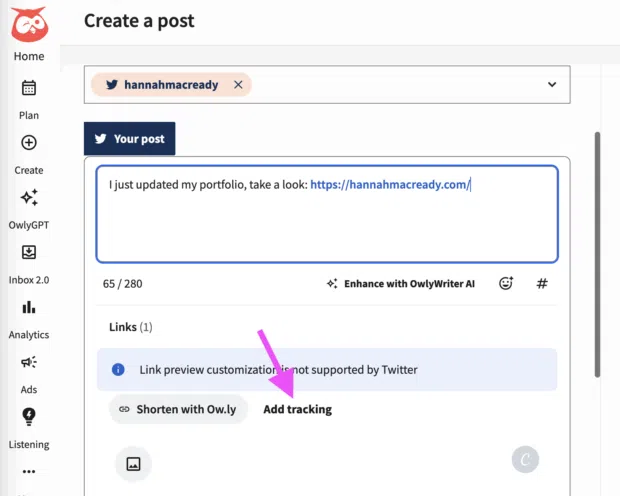
From right here, fill in your UTM parameters utilizing the “presets” drop down menu.
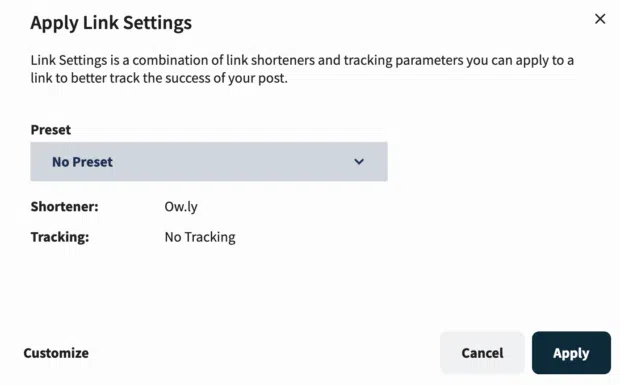
In case you don’t have already got UTM parameter presets, choose Handle hyperlink presets to create one. New to UTMs? Scroll as much as the 5 commonplace UTM parameters part on this information for a fast refresher earlier than you begin.
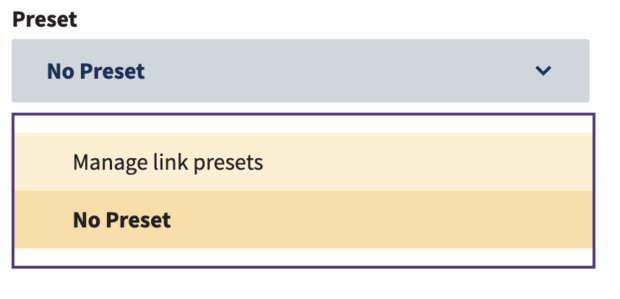
Google Marketing campaign URL Builder
Google’s free Marketing campaign URL Builder is a fast option to create UTM-tagged hyperlinks for any marketing campaign. It’s particularly useful when you’re sending hyperlinks by means of channels outdoors Hootsuite, like accomplice emails or QR codes.
To start, go to Google’s Marketing campaign URL Builder.
Enter your web site URL within the first subject.
Fill within the required UTM fields:
Marketing campaign Supply (utm_source): e.g., instagram
Marketing campaign Medium (utm_medium): e.g., social
Marketing campaign Identify (utm_campaign): e.g., spring_sale
(Elective) Add:
Marketing campaign Time period (utm_term): for key phrases or viewers segments
Marketing campaign Content material (utm_content): for inventive variations or A/B checks
Right here’s how we did it:
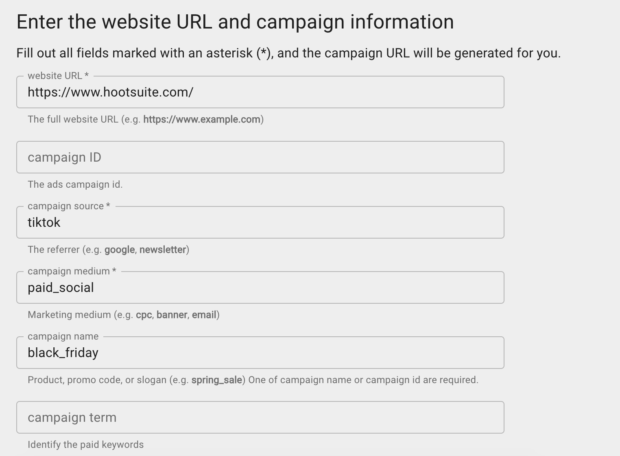
Subsequent, copy the generated hyperlink on the backside, and shorten it earlier than posting to maintain it user-friendly (you can too use Hootsuite’s Ow.ly for this). Then, add it to your subsequent marketing campaign and also you’re prepared to begin monitoring!
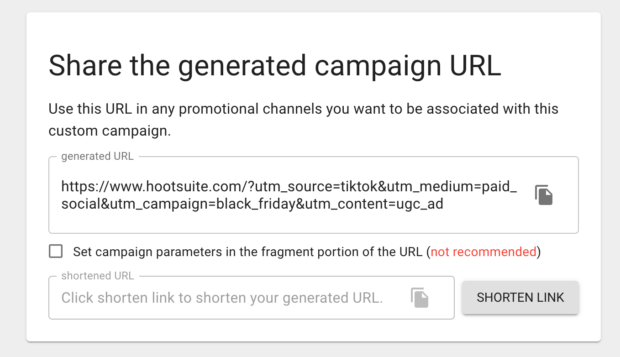
Professional tip: Whether or not you’re utilizing Hootsuite or Google’s software, all the time double-check your spelling and hold your UTM parameters lowercase. Small inconsistencies can cut up your knowledge into a number of rows in your studies.
How one can monitor and report on UTM efficiency
UTM parameters solely assist when you really take a look at the information they gather. As soon as your tagged hyperlinks are out on this planet, you want to know the place to search out the outcomes, tips on how to hold them clear, and tips on how to report on them in a method that’s simple on your crew to make use of.
Use Google Analytics 4 (GA4)
Google Analytics 4 is among the commonest instruments for monitoring UTM efficiency. As soon as your hyperlinks are tagged, right here’s the place to search out the information:
In GA4, go to Reviews > Acquisition > Visitors acquisition.
Change the first dimension to Session supply/medium or Session marketing campaign to see efficiency by UTM parameters.
Use secondary dimensions to drill down additional. For instance, by Session content material to check creatives.
That is the place you possibly can see:
Which sources are driving site visitors probably the most
Which campaigns result in probably the most conversions
Which inventive variations carry out greatest
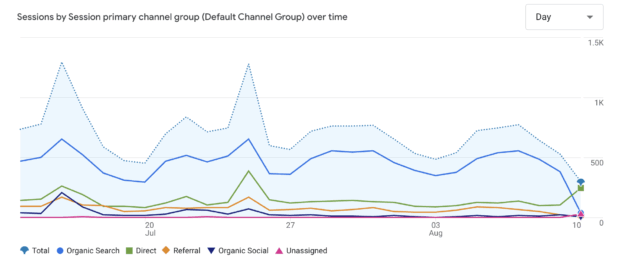
Professional tip: Arrange Exploration studies in GA4 for recurring views of UTM knowledge, so that you don’t must rebuild filters each time.
Monitor with Hootsuite
In case you’re utilizing Hootsuite Composer so as to add UTMs, you can too monitor outcomes inside Hootsuite Analytics.
Go to Analytics and open the Publish efficiency or Customized studies part.
Filter by marketing campaign to see clicks, site visitors, and conversions tied to your UTM-tagged hyperlinks.
Examine outcomes throughout networks with out switching between a number of analytics instruments.
Use spreadsheets or dashboards
When you begin creating UTM hyperlinks, they will pile up rapidly. Holding a central log saves time and prevents duplicate or inconsistent codes.
Your spreadsheet ought to embody:
Full URL with UTM parameters
Brief hyperlink
Particular person UTM values (supply, medium, marketing campaign, time period, content material)
Creation date
Notes (e.g., inventive sort, viewers phase)
Professional tip: Use Google Sheets with Google’s Looker Studio to routinely visualize efficiency from GA4 or Hootsuite. This provides you a light-weight dashboard with out paying for additional instruments.
5 greatest practices for utilizing UTM parameters, in response to the consultants
Wish to get higher at creating, managing, and studying out of your UTM parameters?
I spoke to Fanny Lau, Social Media and Communications Supervisor at LivePerson about how she makes use of UTMs to maintain monitoring clear, constant, and genuinely helpful.
1. Maintain naming conventions easy and self-explanatory
In terms of naming conventions, Lau retains two issues in thoughts: easy and self-explanatory.
She builds UTM names with the tip report in thoughts — the sort somebody from one other division may open months later. “I attempt to consider how the attributes I exploit will present up in a report that somebody on a special crew could be referencing, and the way clear it could be for them to decipher,” she explains.
Her method means marketing campaign names which are brief, descriptive, and constant. For instance, she makes use of social-blog-2025 for all weblog shares and social-events-2025 for all occasion promotions. One look at a report and anybody can inform what the site visitors pertains to.
The lesson? UTM naming conventions aren’t only for you, they’re for everybody who may use your knowledge later.
2. Double-check for small errors that break monitoring
Most UTM errors aren’t dramatic. They’re tiny, easy-to-miss errors. However even small errors or typos can break your monitoring, and trigger your UTM parameters to be defective.
“It could be a minor typo, a logo that will get added, or the ? after the URL disappearing,” Lau says. “These seemingly minor issues do have an effect on how knowledge reveals up in your reporting — if it reveals up in any respect.”
Lau’s repair is straightforward: decelerate. Even when utilizing a template, take a remaining look earlier than hitting publish. These additional 10 seconds can prevent hours of cleanup later.
3. Doc and share your course of
UTMs can get messy quick if a number of persons are creating hyperlinks with out a shared system. Lau’s answer is to maintain one grasp spreadsheet of all lively and previous UTMs — and make it simple to search out.
“I hyperlink ours in my crew’s shared Canvas in Slack,” she says. “That method, it’s all the time useful.” This spreadsheet contains every full URL, its brief hyperlink, the person parameters, and any notes about the place and the way it’s used.
She additionally standardizes creation by utilizing Google Analytics’ Marketing campaign URL Builder. “It reduces errors and ensures we’re all following the identical format,” she says.
The aim is to make UTMs a shared language, not a private behavior.
4. Use UTM knowledge to form content material technique
For Lau, UTM monitoring helps show outcomes whereas additionally revealing patterns that information what she posts subsequent.
“With the information collected by means of UTM tags, I can see which items of content material resonate with which audiences on which channels,” she says.
One instance: LivePerson seen extra click-throughs from Fb to touchdown pages that featured academic sources. That perception straight formed their technique. “We leaned into that content material as a part of our ongoing plan,” she explains.

In case you’re tagging persistently, this type of studying turns into a byproduct of your common reporting.
5. In case you’re not utilizing UTMs but, begin at this time
It sounds apparent, however Lau says one of many largest errors she’s seen is solely not utilizing UTMs in any respect, particularly for natural social.
“There may be a lot helpful knowledge you possibly can collect and study from,” she says. Her recommendation: don’t look forward to the “good” course of earlier than beginning.
“To get began utilizing UTMs successfully, I’d suggest connecting with somebody in your digital advertising crew to study from them and align on what your crew might already be doing,” she provides. Even a fundamental setup is best than no monitoring in any respect.
UTM parameter FAQs
What are UTM parameters used for?
UTM parameters are used for monitoring the place clicks on a hyperlink come from and the way folks discovered an internet web page. They assist entrepreneurs see which posts, advertisements, or emails usher in probably the most guests and measure how effectively every marketing campaign is performing.
How do I create a UTM monitoring hyperlink?
A UTM monitoring hyperlink is created by including brief bits of textual content to the tip of a URL to label its supply, medium, and marketing campaign. Free instruments like Hootsuite Composer or Google’s Marketing campaign URL Builder make it simple to construct these hyperlinks with out having to sort the codes manually.
Do UTM parameters have an effect on web optimization?
UTM parameters don’t have an effect on web optimization. Search engines like google ignore them, so they don’t change the web page content material or hurt search rankings. They’re purely for monitoring functions in analytics instruments.
The place can I see UTM marketing campaign knowledge?
UTM marketing campaign knowledge could be seen in Google Analytics 4 beneath site visitors or marketing campaign studies. It will also be considered in Hootsuite Analytics if the hyperlinks had been shared by means of Hootsuite with UTM tags utilized.
Can I exploit UTM parameters on social media?
UTM parameters can be utilized on any hyperlink shared on social media, together with posts, Tales, advertisements, and profile hyperlinks. They assist determine which networks and content material sorts drive probably the most clicks to a web site.
What’s the distinction between UTM medium and supply?
The distinction between UTM medium and supply is that medium describes the kind of channel, comparable to social, e mail, or paid search, whereas supply names the particular place the press got here from, comparable to Instagram, LinkedIn, or a e-newsletter.
Simply create UTM parameters and monitor the success of your social efforts utilizing Hootsuite. Attempt it free at this time.



